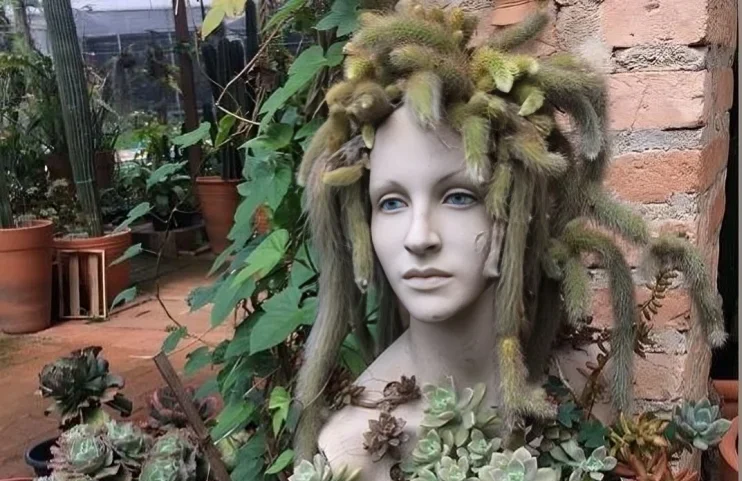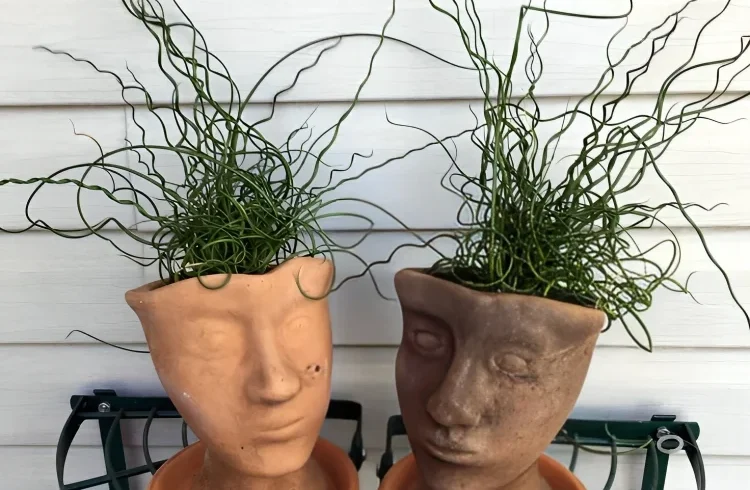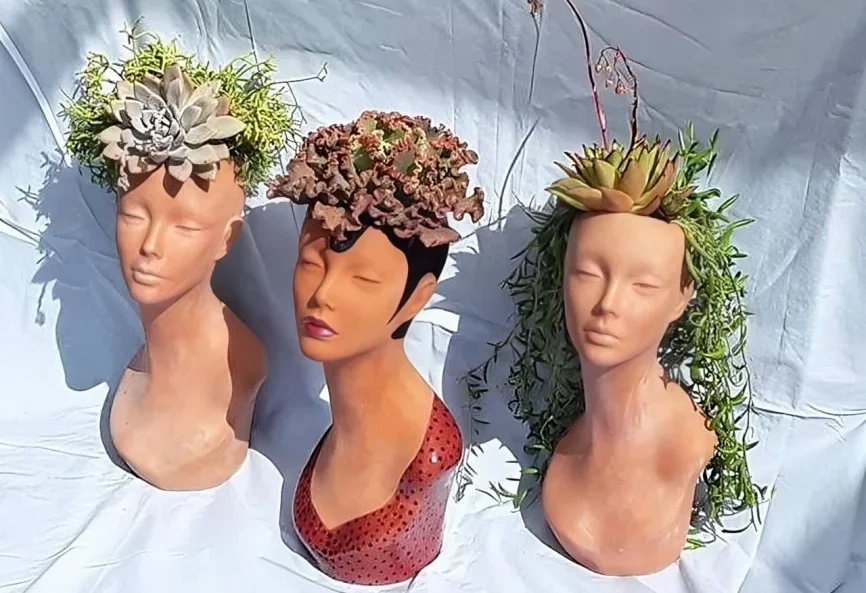Head planters are trending, and their “hair” makes them extra fun. Deciding what to use to decorate a planter with hair not only transforms plain décor but also creates a bold statement piece. For example, cascading greenery or bright yarn can instantly change a simple pot into playful art.
The best plants and materials to use as hair in a planter include cascading ivy, string of pearls, and fishbone cactus. Moreover, moss, synthetic wigs, yarn, and coir also work beautifully. However, plants require care, while faux options last longer. In addition, mixing both creates exciting and stylish looks.
Similarly, using ribbons or beads can enhance volume and texture. Since each choice brings personality, experimenting is always rewarding. Consequently, your head planter becomes one-of-a-kind. Yet, remember that certain plants require proper sunlight. Therefore, always match materials with growing conditions. Because this balance matters, your planter’s hair will thrive indoors or outdoors.
Why Choosing the Right Hair-Style Matters for a Head Planter

The hairstyle defines the planter’s personality, making it playful, elegant, or bold. Using the right plants and materials ensures a balance between beauty and practicality. A thoughtful choice also guarantees healthy growth or long-lasting style.
Visual Impact and Creative Aesthetics
The “hair” gives head planters their charm, personality, and distinct look. Cascading plants or bold fibers create hairstyles ranging from playful curls to sleek edges. Choosing what to use to decorate a planter with hair carefully ensures your pot becomes more than a container—it transforms into functional art.
Texture and volume also influence the overall mood and aesthetic. For example, trailing ivy creates elegance, while spiky grasses give edgy vibes. Moreover, adding colorful accents like moss or yarn provides extra personality. Because pairing different textures adds depth, your head planter always looks eye-catching in any space.
Plant Health and Growth Conditions
The right choice balances beauty with plant health and growing conditions. Since some hair-like plants thrive indoors with low light, others require bright sun. However, selecting what to use to decorate a planter with hair poorly can lead to unhealthy growth, mold, or disappointing results.
Non-plant materials eliminate this issue, although they require secure attachment. For instance, moss, coir, or faux hair must be anchored firmly. In addition, careful placement prevents shedding and moisture buildup. Therefore, considering both growth needs and maintenance ensures your head planter remains stylish and durable long-term.
Types of Plants to Use as Hair in a Planter

Different plants create different hair effects, from cascading curls to upright spikes. Selecting the right plant depends on light, care needs, and the desired hairstyle. With trailing ivy, moss, or succulents, head planters become lively décor pieces.
Trailing and Cascading Plants
Trailing plants create the most natural “hair” effect for face planters. Popular choices include:
-
String of Pearls: Creates bead-like curly hair.
-
English Ivy: Elegant cascading strands for classic styles.
-
Burro’s Tail (Sedum): Thick trailing leaves mimic braids.
These plants flow gracefully, offering hairstyles that move like real hair. Their cascading nature perfectly suits tall or elevated head planters.
Spiky or Upright Plants for Planter Hair
Spiky plants mimic short, edgy, or textured hairstyles that suit bold designs. If you’re deciding what to use to decorate a planter with hair, excellent options include aloe vera, ponytail palm, or ornamental grasses. Moreover, these choices offer structure and contrast that instantly elevate a plain planter.
Because upright leaves stand tall, they can resemble mohawks, dreadlocks, or modern short cuts. In addition, their low-maintenance care makes them ideal for beginners. Similarly, pairing spiky varieties with smaller trailing plants creates depth and a stylish layered look. Consequently, your head planter feels balanced, fun, and full of personality.
Plants with Texture and Volume

Volume is vital when styling planter hair, because fullness creates strong visual impact. If you’re deciding what to use to decorate a planter with hair, ferns, moss, and the fishbone cactus are excellent options. Moreover, these plants provide thickness, texture, and vibrant greenery.
Ferns soften facial features, resembling natural curls. In addition, the fishbone cactus delivers a quirky, messy style that feels playful. Moss offers gentle softness and blends beautifully with synthetic accents. Consequently, these choices ensure your planter hair always looks lively, thick, and stylish.
Long-Lasting vs. Seasonal Plants
Some hair-like plants thrive year-round, while others provide only seasonal appeal. For example, hardy succulents like sedum are low-maintenance choices that last long. Moreover, they withstand varied conditions, making them dependable planter companions. If you are caring for indoor greenery, it’s also important to monitor your plants for signs of stress, such as falling leaves—issues similar to those seen in rubber trees, which can provide helpful tips for maintaining plant health.
Seasonal flowering plants, however, bring bursts of orange, pink, or yellow color but eventually fade. Therefore, mixing permanent greenery with seasonal blooms ensures freshness throughout the year. In addition, this balance keeps your planter visually exciting across months, preventing dull or lifeless designs.
Table: Best Plants for Head Planter Hair
| Plant Name | Hair Style Look | Light Needs | Indoor/Outdoor | Care Level |
|---|---|---|---|---|
| String of Pearls | Beaded curls | Bright light | Indoor | Moderate |
| English Ivy | Cascading strands | Indirect sun | Indoor/Outdoor | Easy |
| Burro’s Tail | Braided texture | Bright sun | Indoor | Moderate |
| Fishbone Cactus | Messy quirky style | Medium light | Indoor | Easy |
| Ferns | Curly full volume | Low light | Indoor | Easy |
| Ponytail Palm | Ponytail effect | Bright sun | Indoor/Outdoor | Easy |
Non-Plant Materials to Use as Hair in a Planter

Faux hair, yarn, moss, and coir are great alternatives to living plants. These materials require less maintenance yet provide creative, lasting results. They also allow experimentation with colors, textures, and bold designs.
Faux Hair, Yarn, Ropes, and Synthetic Fibers
For long-lasting styles, synthetic materials are perfect. Faux hair, doll wigs, or costume wigs can be trimmed and styled like real hair.
Yarn and ropes create colorful braids, twists, or curls. Synthetic fibers withstand humidity and sunlight better than some plants. These options allow playful creativity without plant maintenance.
Natural Fibers: Moss, Coir, Jute, and Lichen
Natural fibers bring earthy authenticity. Moss is soft, lush, and perfect for curly textures. Coir and jute mimic dreadlocks or textured braids.
Lichen adds whimsical, rustic touches for outdoor planters. These fibers pair beautifully with real plants, blending nature with design. They also require less watering and fewer replacements.
Accessories and Creative Additions
Accessories transform planter hairstyles further. Beads, ribbons, clips, or artificial flowers can decorate hair. Adding small accents personalizes your planter.
Even seasonal decorations, like holiday garlands or tiny hats, create themed displays. Mixing plants with accessories ensures your planter hair always feels fresh and engaging.
Securing Non-Plant Materials Safely
Materials must be attached carefully. Use floral wire, glue guns, or wrapping techniques. Anchoring hair to the planter rim prevents slipping.
Water-resistant adhesives or clips are essential outdoors. Proper attachment ensures durability and keeps hairstyles looking neat. This avoids frequent repairs or replacements.
Styling Tips and Design Ideas for Planter Hair
Styling planter hair involves mixing textures, lengths, and accessories for impact. Adding ribbons, beads, or layered greenery gives depth and personality. With imagination, every planter hairstyle becomes unique and expressive.
Playing with Colors and Themes
Colors dramatically affect a person’s personality. Bright yarn offers playful looks, while dark moss creates earthy tones.
You can match a planter’s hair with home décor themes. For example, green ivy for a natural vibe, or vibrant yarn for boho energy. Mixing textures adds dimension to your design.
Hair Length, Layers, and Blending Materials
Varying hair lengths enhances realism. Trailing plants create long “locks,” while moss fills volume.
Layered designs mix cascading plants with synthetic fibers for fuller styles. Combining materials adds depth and prevents flat appearances. This technique makes your planter visually dynamic.
Common Mistakes When Decorating Planter Hair
Overcrowded planters or ignoring care needs often lead to poor results. Choosing the wrong plants or fragile materials can damage the look quickly. Avoid these mistakes to keep your planter stylish, balanced, and long-lasting.
Choosing Wrong Materials for Conditions
Not all plants thrive everywhere, and therefore careful selection is essential. For example, delicate trailing plants should not sit in dark corners. Moreover, untreated fabrics can mold outdoors and quickly lose charm. However, weather-resistant choices ensure long-lasting results.
Because planning prevents problems, you avoid wasted effort and disappointing outcomes. In addition, sturdy materials reduce constant replacements. Similarly, choosing durable plants guarantees stronger growth.
For instance, understanding how to care for medicinal aloe plants can guide you in selecting low-maintenance, resilient greenery for your space (learn more here). Although faux fibers lack life, they remain reliable. Consequently, your planter hair stays attractive. Yet without thoughtful planning, results often fail.
Overcrowding or Blocking Planter Features
Too much hair can easily hide planter facial details, and therefore balance matters. While dense coverage looks dramatic, exposure ensures personality shines through. Moreover, allowing space highlights planter expressions.
Overcrowding also reduces airflow, consequently stressing your plants. Instead, trim regularly to maintain natural shapes. Similarly, leaving gaps enhances charm. Although extra volume seems appealing, moderation works better. In addition, selective layering avoids clutter. Because styling impacts longevity, careful trimming ensures beauty. Therefore, your planter remains stylish.
Step-by-Step DIY Example: Creating a Planter Hairstyle

-
Select a head or face planter.
-
Choose one main plant or material.
-
Prepare soil, drainage, or base support.
-
Add a trailing plant or attach synthetic hair.
-
Secure with clips, wire, or moss padding.
-
Style hair into curls, braids, or layers.
-
Maintain with trimming, watering, or replacing.
This simple method works for both plant and non-plant materials.
Inspiration Gallery: Fun Planter Hair Ideas
-
String of pearls + moss = curly layered bob style.
-
Ponytail palm alone = sleek pulled-back ponytail.
-
Ivy + yarn braids = colorful boho hairstyle.
-
Fishbone cactus + ribbons = funky, messy cut.
-
Faux wig with beads = festival-ready look.
Experimentation ensures your planter looks unique and playful.
Conclusion
Using plants and materials to use as hair in a planter makes decor fun, stylish, and endlessly creative. For example, cascading ivy, faux wigs, or moss can instantly transform a plain pot. Moreover, adding yarn, coir, or ribbons allows even more personal touches. Although live plants need regular care, faux options provide lasting beauty.
In addition, mixing greenery with fibers creates bold hairstyles that stand out. Similarly, blending textures ensures visual depth and personality. Yet, avoid overcrowding since balance always matters. Because durability and design must align, choose wisely when deciding what to use to decorate a planter with hair. Therefore, always consider lighting and watering needs for lasting success.
While experimenting, try seasonal themes for variety. Consequently, your planter remains fresh and stylish year-round. Furthermore, sharing unique creations online inspires others to get creative. Instead of buying generic décor, gift customized head planters for a personal touch. With imagination, planning, and the right choices, every planter truly becomes a living piece of art.
FAQ:
What plants look best as hair in a planter?
Trailing plants like string of pearls, ivy, and burro’s tail look most natural. They cascade like real hair and are easy to style.
Can I use non-plant materials for planter hair?
Yes! You can use faux hair, yarn, moss, coir, or synthetic wigs. These options add creativity and require less maintenance than live plants.
How do I secure planter hair materials?
Use floral wire, glue, or clips to anchor materials. For plants, ensure proper soil and drainage. For fibers, attach around the rim or tuck into the planter.
How do I style my planter hair creatively?
Mix textures and lengths. Combine cascading ivy with moss, or add ribbons, beads, or faux flowers. Layering creates a full, dynamic hairstyle.


















